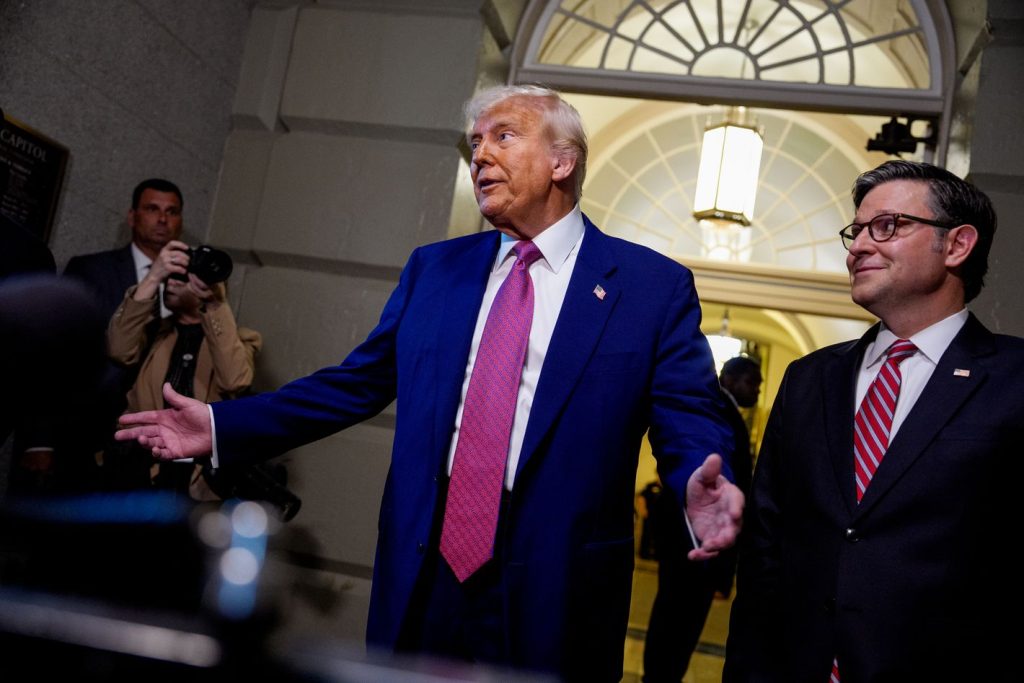Photo: Andrew Harnik/Getty Images
After a 19-hour meeting of the Rules Committee to clear the bill and a 7:00 a.m. vote after wee-hours procedural maneuvering, the House passage of the One Big Beautiful Bill Act of 2025 by the smallest margin imaginable (one vote) was always the the likeliest outcome.
Yes, multiple factions threatened to withhold their votes over this or that provision, most notably the hardline conservatives of the Freedom Caucus and a band of congressmen from high-tax blue states who wanted liberalization of the existing cap on state and local tax (SALT) deductions. But in the end, all the factions got some concessions and virtually no one wanted to be responsible for denying Donald Trump the bill that contained virtually all of his legislative agenda for this year. For their part, Democrats are mostly satisfied that the bill wound up being ugly enough to sustain attacks on the GOP for being determined to cut popular domestic programs like Medicaid and food stamps in order to enact tax cuts mostly benefiting the wealthy.
The House isn’t done with all the arm-twisting, however. The Senate will now take up its version of the bill, and there are a lot of differences between how the two chambers have approached the measure. For one thing, the Senate assumes that a major portion of the tax cuts Trump has asked for will not increase the budget deficit because they extend 2017 tax cuts that expire this year, so that will have to be worked out. Senators also have to deal with the parliamentarian possibly ruling provisions non-germane to fiscal matters and thus ineligible for inclusion in a reconciliation bill. The Senate GOP has its own factions, including fiscal hawks obsessed with debts and deficits (which the House bill boosts) and several who really don’t like Medicaid cuts. They’ll have the same three votes to spare the House eventually had. But once it’s done, then the really hard part starts of getting the House and Senate together on a single documents. The GOP’s self-imposed deadline for sending the bill to Trump is July 4, in time to preempt a debt-limit crisis that might otherwise appear in August or September. That isn’t a lot of time for additional stalls in the process.
The last minute changes to the House budget bill were significant but didn’t change its essential thrust. The SALT lobby got an increase in the deduction cap from $10,000 to $40,000 (with an inflation adjustment) available to itemizers earning under a half mil a year. A new Medicaid “work requirement,” which will now be implemented by the states two years earlier, will wind up killing health insurance for at least 7 million people, according to an estimate from the non-partisan Congressional Budget Office; another 8 million are at risk thanks to elimination of certain Obamacare private health insurance subsidies. Cuts in federal payments for the SNAP (food stamps) program would likely cost 11 million people some or all of their existing benefits.
The tax cuts are a mix of high-end and corporate benefits, mostly by extension of the 2017 Trump tax cuts, and some crowd-pleasers from the 2024 campaign trail, like elimination of taxes on tips and overtime pay, and a boost in the standard deduction for seniors. Overall, in a CBO estimate you will hear much about from Democrats, the bill would “lead to the bottom 10% of Americans seeing their household resources reduced by 4% — largely through cuts to federal spending on Medicaid and food aid — while the top 10% would see an increase in their resources by 2%.” But the number that could also come back to haunt Republicans if only because of the effect on financial markets is the estimated boost in the national debt by $3.8 trillion.
Republicans will cheer the tax cuts and the big new infusion of money the bill provides for deporting immigrants and for the Pentagon, and Democrats will deplore it for shifting wealth upward to an already overstuffed upper class while shredding the safety net and saddling the economy with unnecessary debt. Until Trump signs the final product, the strategy of cramming absolutely everything into one measure will remain risky, but will probably work to keep Republicans in line. The president, of course, is already howling in triumph on Truth Social: “This is arguably the most significant piece of Legislation that will ever be signed in the History of our Country!” The ultimate test of the bill, however, and its relative beauty or hideousness, will be the condition of the economy when midterm voters decide whether to continue or reject Republican control of Congress.

